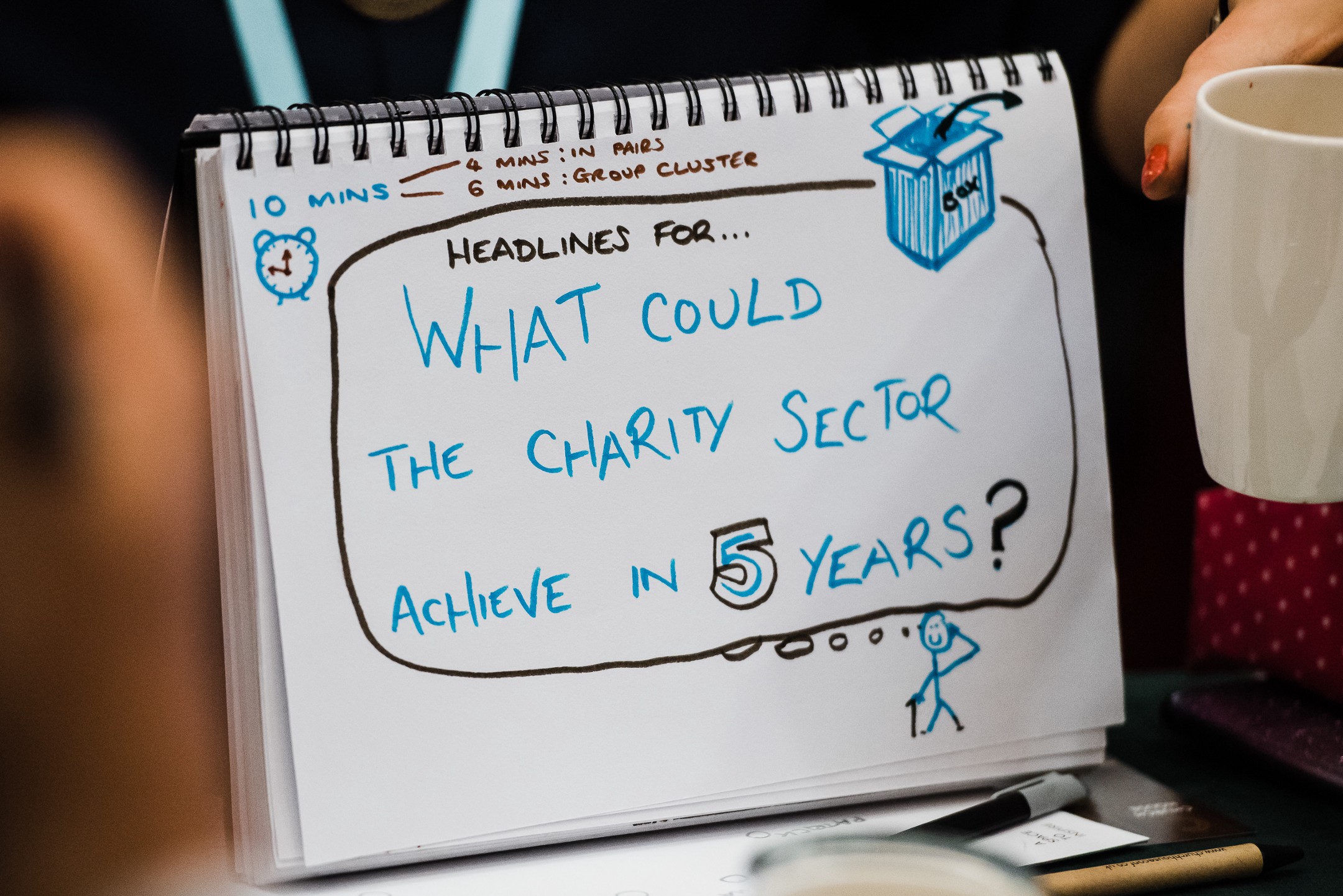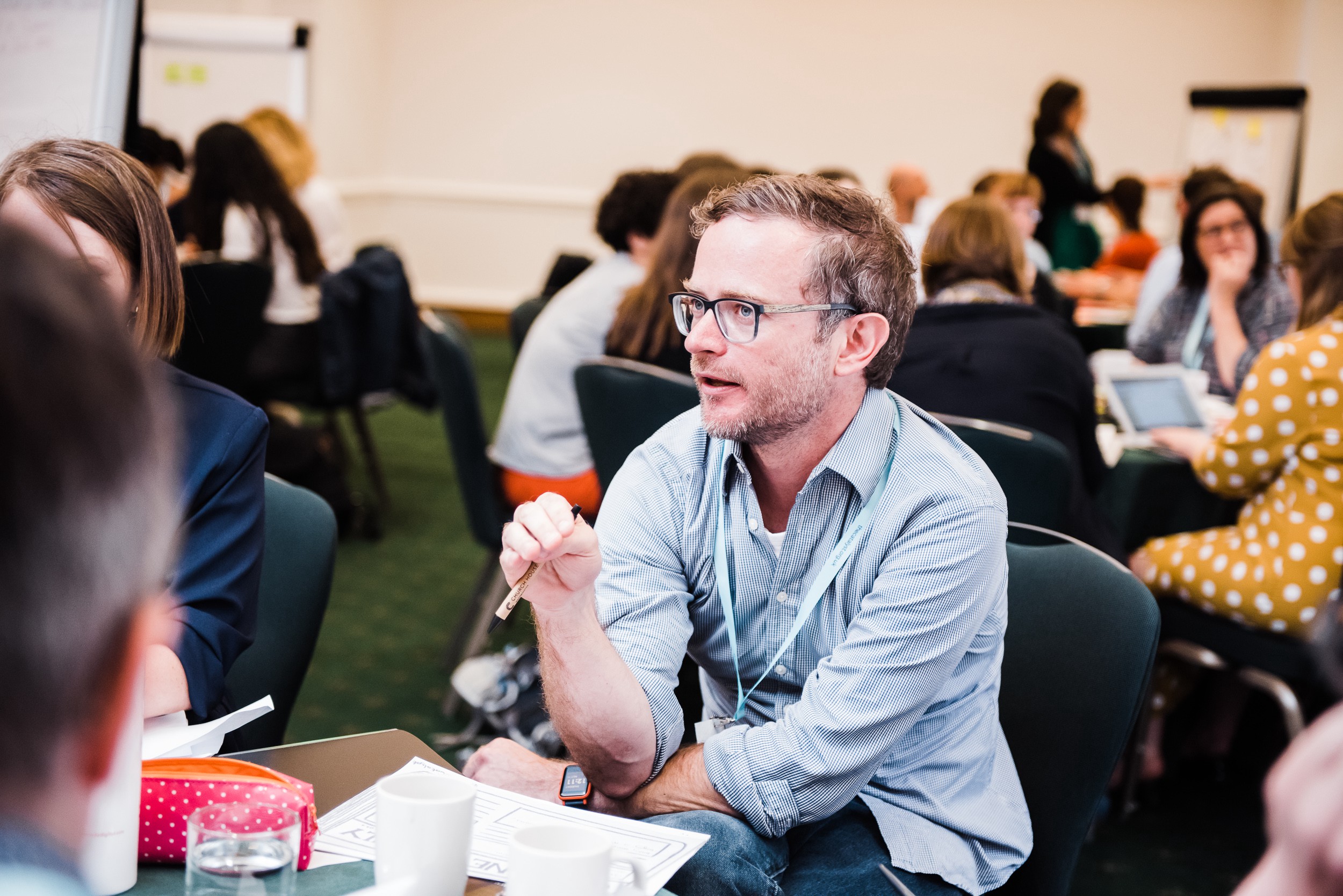
A practical structure for an urgent ambition.
TL/DR there’s a starting structure for Catalyst that helps us get more practical. Check out the draft Theory of Change (below) and look out for the specific ongoing work and opportunities.
The Catalyst started as an ambition to strengthen voluntary and charitable organisations with digital. Thanks to the input from those who joined the inaugural gathering earlier this month as well as ongoing and wide-ranging consultation across the sector, Catalyst has quickly become a collective re-imagining and re-creation of civil society for a digital age.
Not just how we support organisations to respond to the changes in people’s needs, behaviours and expectations, or just to make best use of digital, design and data for social good (as huge as those aspirations are), but how we can collectively re-create civil society so that it works for everyone in an era where digital is so integrated across all areas of our lives.

Some of the most consistent input has been
- A positive impatience to find ways to work together, practically, and to get on with it
- A strong belief that we can lead by example through responsible and ambitious action
- A willingness for connection and collaboration balanced with the energy and efficiency of small teams working towards collective objectives
- The need to balance humility in service, and confidence in what we can do together.
These insights from across the sector have helped to inform our draft Theory of Change for how we can collectively achieve Catalyst’s ambition, building on the activities and experience of thousands of people and organisations. This means we have a starting framework for how Catalyst can operate and over the next few articles, we’ll dive into these areas in more depth, inviting further challenge, participation and development.



Test driven in pursuit of balanced value
The starting point is that we expect this initial framework to change as we develop and gather new insight. We’re following a test-driven approach, which highlights assumptions, ensures decisions are based on evidence/new insight and that we allocate effort in line with confidence of decision. We do this in pursuit of balanced value — balancing individual, collective and environmental value.
Anyone familiar with using Theories of Change will recognise the need to focus on smaller parts of these big outcomes. To do this, we’re using a process called OKRs, which help ensure all activities build towards the Catalyst’s big social outcomes. It breaks down the work into specific Objectives (things we need to bring about in order to realise our Outcomes), and then Key Results — measurable progress towards those Objectives. If your work aligns with any of these Outcomes or Objectives, please get in touch as we would love to explore how the Catalyst might support you to further extend your reach and/or impact.
Key outcomes and work areas
1. An effective, sustainable and collaborative cross-sector network driving sector change — ‘The Network’
The first major outcome is to galvanise an inclusive, growing and thriving community aligned around a shared purpose and ethical responsibility. This reflects the positive impatience expressed by so many in finding practical ways to work together. Here we are exploring how the Catalyst can best be governed and managed as a transparent and accountable network; how it remains inclusive and increasingly diverse; and how it ensures contribution and commitment from all parts of the sector, providing value to all.
2. An increase in the quality, range and uptake of support proven to build the digital knowledge, skills and services of sector—‘Sector Tech’
This second area works to increase the opportunities for voluntary and charitable organisations to develop their work and services as rapidly and efficiently as possible; boosting the quality and volume of relationships between support providers and charities; and increasing the ease and number of charities accessing external help (resources and talent) to support their practice. This includes standards, tools, products, libraries and guidance, all of which improve the charities’ digital capacity.
3. A growing number of VCSOs making effective use of digital, data and technology to improve their services and their organisational resilience—‘Digital Practice’
This third work-stream focuses on ensuring charity decision-makers are supported; are confident in creating responsive organisations; and will harness digital, design and data to advance their charitable objectives. This area is also where we can collectively champion the needs of those furthest from power, with charity leaders as the conduit to big tech and others beyond the sector. Here we will also seek to build collective capacity to support and train charities in using user-led, test-driven responsible practices.
These three primary outcomes and their supporting objectives are underpinned by a focus on the quality and depth of interaction within the network and with the work of Catalyst. There’s something special about organisations whose starting point is the creation of social value, rather than individual or financial gain. There’s something special about the potential relationships and interactions within the sector — something that gives the Catalyst its greatest ingredient for success.
Capturing contributions
We’re developing some consistent ways to capture contributions and progress — and we’ll talk more of that soon. Similarly, in the coming weeks, more details will be shared about each of these three areas — with further calls for partnership and collaboration.
For now, we look forward to your reflections on the draft theory of change, ensuring that we continue to build on and further enable the amazing work of so many extraordinary individuals and organisations in the sector.
TL/DR there’s a starting structure for Catalyst that helps us get more practical. Check out the draft Theory of Change (below) and look out for the specific ongoing work and opportunities.
The Catalyst started as an ambition to strengthen voluntary and charitable organisations with digital. Thanks to the input from those who joined the inaugural gathering earlier this month as well as ongoing and wide-ranging consultation across the sector, Catalyst has quickly become a collective re-imagining and re-creation of civil society for a digital age.
Not just how we support organisations to respond to the changes in people’s needs, behaviours and expectations, or just to make best use of digital, design and data for social good (as huge as those aspirations are), but how we can collectively re-create civil society so that it works for everyone in an era where digital is so integrated across all areas of our lives.

Some of the most consistent input has been
- A positive impatience to find ways to work together, practically, and to get on with it
- A strong belief that we can lead by example through responsible and ambitious action
- A willingness for connection and collaboration balanced with the energy and efficiency of small teams working towards collective objectives
- The need to balance humility in service, and confidence in what we can do together.
These insights from across the sector have helped to inform our draft Theory of Change for how we can collectively achieve Catalyst’s ambition, building on the activities and experience of thousands of people and organisations. This means we have a starting framework for how Catalyst can operate and over the next few articles, we’ll dive into these areas in more depth, inviting further challenge, participation and development.



Test driven in pursuit of balanced value
The starting point is that we expect this initial framework to change as we develop and gather new insight. We’re following a test-driven approach, which highlights assumptions, ensures decisions are based on evidence/new insight and that we allocate effort in line with confidence of decision. We do this in pursuit of balanced value — balancing individual, collective and environmental value.
Anyone familiar with using Theories of Change will recognise the need to focus on smaller parts of these big outcomes. To do this, we’re using a process called OKRs, which help ensure all activities build towards the Catalyst’s big social outcomes. It breaks down the work into specific Objectives (things we need to bring about in order to realise our Outcomes), and then Key Results — measurable progress towards those Objectives. If your work aligns with any of these Outcomes or Objectives, please get in touch as we would love to explore how the Catalyst might support you to further extend your reach and/or impact.
Key outcomes and work areas
1. An effective, sustainable and collaborative cross-sector network driving sector change — ‘The Network’
The first major outcome is to galvanise an inclusive, growing and thriving community aligned around a shared purpose and ethical responsibility. This reflects the positive impatience expressed by so many in finding practical ways to work together. Here we are exploring how the Catalyst can best be governed and managed as a transparent and accountable network; how it remains inclusive and increasingly diverse; and how it ensures contribution and commitment from all parts of the sector, providing value to all.
2. An increase in the quality, range and uptake of support proven to build the digital knowledge, skills and services of sector—‘Sector Tech’
This second area works to increase the opportunities for voluntary and charitable organisations to develop their work and services as rapidly and efficiently as possible; boosting the quality and volume of relationships between support providers and charities; and increasing the ease and number of charities accessing external help (resources and talent) to support their practice. This includes standards, tools, products, libraries and guidance, all of which improve the charities’ digital capacity.
3. A growing number of VCSOs making effective use of digital, data and technology to improve their services and their organisational resilience—‘Digital Practice’
This third work-stream focuses on ensuring charity decision-makers are supported; are confident in creating responsive organisations; and will harness digital, design and data to advance their charitable objectives. This area is also where we can collectively champion the needs of those furthest from power, with charity leaders as the conduit to big tech and others beyond the sector. Here we will also seek to build collective capacity to support and train charities in using user-led, test-driven responsible practices.
These three primary outcomes and their supporting objectives are underpinned by a focus on the quality and depth of interaction within the network and with the work of Catalyst. There’s something special about organisations whose starting point is the creation of social value, rather than individual or financial gain. There’s something special about the potential relationships and interactions within the sector — something that gives the Catalyst its greatest ingredient for success.
Capturing contributions
We’re developing some consistent ways to capture contributions and progress — and we’ll talk more of that soon. Similarly, in the coming weeks, more details will be shared about each of these three areas — with further calls for partnership and collaboration.
For now, we look forward to your reflections on the draft theory of change, ensuring that we continue to build on and further enable the amazing work of so many extraordinary individuals and organisations in the sector.

Support & services
Our free services help you make the right decisions and find the right support to make digital happen.
Learn what other non-profits are doing
39+ organisations share 50+ Guides to how they use digital tools to run their services. Visit Shared Digital Guides.

CAST and Catalyst: the journey, the transition - and beyond





